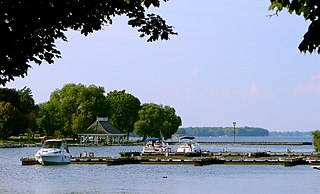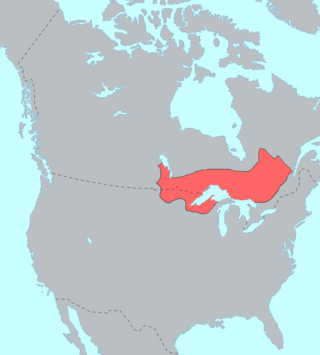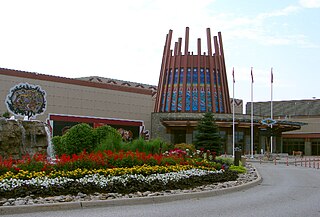Related Research Articles

Orillia is a city in Ontario, Canada, about 30 km north-east of Barrie in Simcoe County. It is located at the confluence of Lake Couchiching and Lake Simcoe. Although it is geographically located within Simcoe County, the city is a single-tier municipality. It is part of the Huronia region of Central Ontario. The population in 2021 was 33,411.

The Ojibwe are an Anishinaabe people whose homeland covers much of the Great Lakes region and the northern plains, extending into the subarctic and throughout the northeastern woodlands. Ojibweg, being Indigenous peoples of the Northeastern Woodlands and of the subarctic, are known by several names, including Ojibway or Chippewa. As a large ethnic group, several distinct nations also understand themselves to be Ojibwe as well, including the Saulteaux, Nipissings, and Oji-Cree.

The District Municipality of Muskoka, more generally referred to as the District of Muskoka or Muskoka, is a regional municipality in Central Ontario, Canada. It extends from Georgian Bay in the west, to the northern tip of Lake Couchiching in the south, to the western border of Algonquin Provincial Park in the east. A two-hour drive north of Toronto, it spans 6,475 km2 (2,500 sq mi). It has some 1,600 lakes, making it a popular cottaging destination.

Simcoe County is located in the central portion of Southern Ontario, Canada. The county is just north of the Greater Toronto Area, stretching from the shores of Lake Simcoe in the east to Georgian Bay in the west. Its most populated city is Barrie. Simcoe County forms part of the Greater Golden Horseshoe area, a densely populated and industrialized region, centred on the Greater Toronto Area.

Ramara is a lower-tier township municipality in Simcoe County, Ontario, Canada.

Severn is a township in south-central Ontario, Canada, located between Lake Couchiching, and the Severn River in Simcoe County.

Lake Muskoka is located between Port Carling and Gravenhurst, Ontario, Canada. The lake is surrounded by many cottages. The lake is primarily within the boundary of the Township of Muskoka Lakes, the southeast corner is within the boundary of the Town of Gravenhurst and another small portion around the mouth of the Muskoka River is within the boundary of the Town of Bracebridge. The town of Bala is located on the southwest shores of the lake, where the Moon River starts. Lake Muskoka is connected to Lake Rosseau through the Indian River and lock system at Port Carling. The lake is mainly fed by the Muskoka River, Lake Joseph and Lake Rosseau.

William Benjamin Robinson was a fur trader and political figure in Upper Canada.

Chippewas of Rama First Nation, also known as Chippewas of Mnjikaning and Chippewas of Rama Mnjikaning First Nation, is an Anishinaabe (Ojibway) First Nation located in the province of Ontario in Canada. The name Mnjikaning, or fully vocalized as Minjikaning, refers to the fishing weirs at Atherley Narrows between Lake Simcoe and Lake Couchiching and it means "in/on/at or near the fence".

Fort William First Nation is an Ojibwa First Nation reserve in Ontario, Canada. The administrative headquarters for this band government is south of Thunder Bay. As of January 2008, the First Nation had a registered population of 1,798 people, of which their on-Reserve population was 832 people.

Shingwaukonse, or Shingwauk was an Anishnaabe chief, who was instrumental in the establishment of the Garden River First Nation near Sault Ste. Marie, Ontario as a signatory to the Robinson Huron Treaty of 1850.

Georgina Island is the largest of the lake islands of Lake Simcoe, located in southern Ontario, Canada. The island is a Native reserve populated by the Chippewas of Georgina Island First Nation, a band of Ojibwa people. It is also within the Town of Georgina and in the Regional Municipality of York.
The Lake Simcoe–Lake Huron Purchase, registered as Crown Treaty Number Sixteen, was signed November 18, 1815 between the Ojibwa and the government of Upper Canada. It purchased a large portion of the lands between Lake Simcoe and Lake Huron, including all of the territory upon which the Penetanguishene Road had recently been cut.
Beausoleil First Nation is an Ojibwe First Nation band government located in Simcoe County, Ontario, Canada. The main settlement of the Beausoleil First Nation is on Christian Island, Ontario, Canada in southern Georgian Bay. As of 2018, the total number of status Native Americans registered with the First Nation is 2,587. The on-reserve population is 614.
Big Grassy First Nation is an Ojibwe or Ontario Saulteaux First Nation band government located in Rainy River District, Ontario near Morson, Ontario.
The Black River is a river in Simcoe County, the District Municipality of Muskoka, the City of Kawartha Lakes, and Haliburton County in Central Ontario, Canada. It is part of the Great Lakes Basin, and is a right tributary of the Severn River.
The 2015–16 GMHL season was the tenth season of the Greater Metro Junior A Hockey League (GMHL). The thirty-two teams of the GMHL played 42-game schedules.
John Aisance was a chief among the Chippewas of Lakes Huron and Simcoe and leader of the Otter clan of that people from at least 1815 until his death in 1847. He participated in the Lake Simcoe–Lake Huron Purchase in 1815, served the provincial government during the Upper Canada Rebellion, and was the first and founding chief of the Beausoleil First Nation.
Yellow Head, "Chief of Lake Simcoe", was the "head chief" of the Chippewas of Lakes Huron and Simcoe from sometime before 1797 until 1817. Evidently he was already exercising that office when, in the late summer of 1797, he led a contingent of some 140 of his Ojibwe to York and Niagara, the administrative centres of Upper Canada, seeking redress of grievances concerning absence of government contact and non-receipt of customary "annual Presents". Yellow Head was instrumental in persuading the Ojibwe of the Home District of Upper Canada to take up arms in support of the British during the War of 1812, and personally saw action at the Battle of York in April 1813, where he sustained wounds that appear to have curtailed his subsequent career. His son Musquakie, similarly known as Yellow Head, and as William Yellowhead, seems to have assumed Yellow Head's chiefly duties by 1815, and in 1817 he formally replaced his father as head chief. The date and circumstances of Yellow Head's death are not known.
Joseph Snake was an Ojibwe chief belonging to the Chippewas of Lakes Huron and Simcoe from sometime before 1842 until his death in 1861.
References
- ↑ "Chief William "Big Shilling" Shilling Yellowhead".
- ↑ http://www.aadnc-aandc.gc.ca/eng/1370372152585/1370372222012#ucls15 (Treaty 18)
- ↑ "Biography – MUSQUAKIE – Volume IX (1861-1870) – Dictionary of Canadian Biography".
- ↑ "Biography – MUSQUAKIE – Volume IX (1861-1870) – Dictionary of Canadian Biography".
- ↑ "Biography – MUSQUAKIE – Volume IX (1861-1870) – Dictionary of Canadian Biography".
- ↑ http://www.aadnc-aandc.gc.ca/eng/1370372152585/1370372222012#ucls15 (Treaty 16)
- ↑ http://www.aadnc-aandc.gc.ca/eng/1370372152585/1370372222012#ucls15 (Treaty 18)
- ↑ Murray (ed.), Muskoka and Haliburton, 104
- ↑ Murray (ed.), Muskoka and Haliburton, 109
- ↑ Murray (ed.), Muskoka and Haliburton, 110
- ↑ Indian Treaties and Surrenders, Vol. 1, 117 (Treaty 48)
- ↑ Murray (ed.), Muskoka and Haliburton, 115-16
- ↑ Murray (ed.), Muskoka and Haliburton, 119
- ↑ Murray (ed.), Muskoka and Haliburton, 114
- ↑ Murray (ed.), Muskoka and Haliburton, 114-15
- ↑ Murray (ed.), Muskoka and Haliburton, 111
- ↑ Murray (ed.), Muskoka and Haliburton, 120
- ↑ "Biography – MUSQUAKIE – Volume IX (1861-1870) – Dictionary of Canadian Biography".
- ↑ Murray (ed.), Muskoka and Haliburton, 120
- ↑ Murray (ed.), Muskoka and Haliburton, 131-32